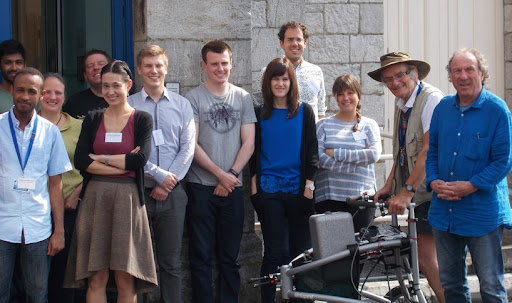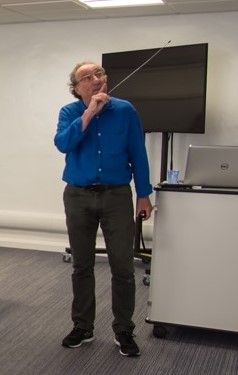
Physiology News Magazine
Obituary: David Charles Ogden (1948-2021)
Membership
Obituary: David Charles Ogden (1948-2021)
Membership
https://doi.org/10.36866/pn.126.46
Written by Professor David Colquhoun,
University College London, UK
I could scarcely believe it when I heard of David Ogden’s sudden death at the age of only 73. David was born in London, the first child of Charles Joseph and Doris Edith Ogden.
David Ogden joined UCL in the 1960s. For a while he was a technician in my lab. I recall that he had Higher National Diplomas (at the time that was a technical qualification). I have always liked late developers (being one myself) and I encouraged him to go further. He became a Member of the Institute of Biology (MIBiol), which was deemed to be a degree-equivalent qualification. That was enough to qualify him to start as a research assistant in Bernard Katz’s famous Biophysics Department in 1972.
He worked there with Rolf Niedergerke and Sally Page who, after a tussle with the University of London dinosaurs about whether his MIBiol was a sufficient qualification, got him enrolled for a part-time PhD. For his first three years in Biophysics he overlapped with another research assistant, David Gadsby, with whom he collaborated on aspects of the sodium pump in skeletal muscle. (Gadsby, Niedergerke and Ogden, 1977). His PhD thesis was “Analysis of the hyperpolarisation associated with active exchange of sodium for potassium in skeletal muscle” (1981). Sally Page pointed out that some of his characteristics reminded her of Rolf Niedergerke: “the hands-on skill with equipment, the collecting of possible spare parts, the scrupulous analytical approach and concern for sources of error, the lack of self-promotion”. His modesty was legendary. That hasn’t helped with writing this obituary, but it was an appealing characteristic in a time when self-promotion became increasingly part of the job of academics.
In 1970 I had left for the US and didn’t get back to UCL until 1979. I was delighted to be reunited with David. He stayed in our C-floor lab until 1986. They were heady times, the early days of single ion channel recording. I had met Bert Sakmann in 1977, the year after his first publication on single ion channels (Neher and Sakmann, 1976), and he and I had agreed to test some predictions made by Colquhoun and Hawkes (1977). Subsequent visits to Göttingen gave us early access to the methods published by Hamill et al .(1981). We got a circuit for a patch clamp via Erwin Neher, and I recall clearly David and I in the lab soldering together our first patch clamp in 1979 or 1980. It involved a search through catalogues for the least noisy 50 GW resistors. David’s knowledge of electronics and his talent for building of apparatus proved invaluable and that led to the first publication of single ion channels from UCL using the gigohm seal method (Ogden, Siegelbaum and Colquhoun, 1981). During the 1980s, David proved himself to be a superb experimenter and he published several highly original studies on single ion channels.

In 1984, while continuing his research, David took on the huge task of organising the course on Microelectrode Techniques for Cell Physiology. Professor Anne Warner had proposed a course to teach methods, but from the start David did the work and kept it going over the next 37 years. It was a huge amount of work because the course was intensively practical. It involved the organisation and erection of six, and later ten, electrophysiological rigs from scratch at the Marine Biology lab in Plymouth. Over 600 students from around the world have now had the chance to do experiments with their own hands with the help of experienced scientists at each setup. The experiments were accompanied by lectures that explained the necessary theory. David asked me to talk about the practice and theory of single channel measurements and I loved the annual trip to Plymouth every year but one from 1984 to 2017. At the first meeting the speakers included Bernard Katz and Richard Keynes.
In 2021, the course had to be virtual because of COVID-19 and the lectures were recorded. Of course, they are a poor substitute for the real course because the main virtue of the course was that students were able to do experiments with their own hands.
At least we can be grateful that if it were not for COVID, the lectures might never have been recorded. They will form part of his memorial.

After David left UCL he had a 3-year stint as a lecturer in Pharmacology at King’s College London, but soon moved on to spend 16 years as a Senior Scientist at the MRC National Institute for Medical Research, London (later the Crick Institute). There he worked with David Trentham, John Corrie and George Papagiorgiou, developing photo-cleavable caged compounds, in particular caged neurotransmitters, to study synaptic receptor activation and properties in situ. From then on, David concentrated on optical methods. His deep knowledge of optics and electronics, and his legendary ability to make equipment, made a brilliant career.
In 2004, together with Céline Auger, he moved to Université Paris Descartes where he stayed until his untimely death. He worked on further development of caged compounds and optical approaches to localise photolysis to a single synapse. David was never far from synapse biophysics. His last paper was published in 2018 (Palma-Cerda, Papageorgiou, Barbour, Auger and Ogden, 2018).
I can’t put it better than Stephen Brickley: “Like many people who will contribute to this document, Dave gave me his time and knowledge selflessly, teaching me about amplifiers, optics, scientific integrity, and the dying art of humility”. David is survived by his wife, Céline Auger, their two children, Eleanor and Félix, by his first wife, Judith and their two children, Vanessa and Clara, and by his brother, Paul, and sister, Marian.
Footnotes
There are more pictures and reminiscences on my blog: http://www.dcscience.net/in-memoriam/the-diary-june-2013-may-2014/#070913.
His publications can be found at https://www.researchgate.net/profile/David-Ogden-4/research.
To learn more about how much David Ogden was loved by his friends, there are tributes from many of them at https://docs.google.com/document/d/1CiG4s5BPTRE3KioPOD8QZGB6fs81dof0D-XInuVbmvM/edit.
David had a lifelong passion for football. You can read about it here: https://www.hamhigh.co.uk/news/obituaries/david-ogden-hasdied-aged-73-8561236.
I owe thanks to many people who’ve helped with this tribute, especially Dr Céline Auger, Dr Sally Page and Dr Loise Morgan, and his younger brother, Paul Ogden.
References
Colquhoun D, Hawkes AG (1977). Relaxation and fluctuations of membrane currents that flow through drug-operated channels. Proceedings of the Royal Society of London. Series B, Biological Sciences 199, 231-262.
Gadsby DC, Niedergerke R, Ogden DC (1977). The dual nature of the membrane potential increase associated with
the activity of the sodium/potassium exchange pump in skeletal muscle fibres. Proceedings of the Royal Society of
London. Series B, Biological Sciences 198(1133), 463-472. doi:10.1098/rspb.1977.0110.
Hamill OP, Marty A, Neher E, Sakmann B, Sigworth FJ (1981). Improved patch clamp techniques for high resolution current recording from cells and cell-free membrane patches. Pflügers Archive – European Journal of Physiology, 391, 85-100.
Neher E, Sakmann B (1976). Single channel currents recorded from membrane of denervated frog muscle fibres.
Nature 260, 799-802. Ogden DC, Siegelbaum SA, Colquhoun D (1981). Block of acetylcholine-activated ion channels by an uncharged local anaesthetic. Nature 289, 596-598.
Palma-Cerda F, Papageorgiou G, Barbour B, Auger C & Ogden D (2018). Photolysis of a caged, fast-equilibrating glutamate receptor antagonist, mni-caged gamma-dglutamyl-glycine, to investigate transmitter dynamics and receptor properties at glutamatergic synapses. Frontiers in Cellular Neuroscience 12, 465. doi:10.3389/fncel.2018.00465.
